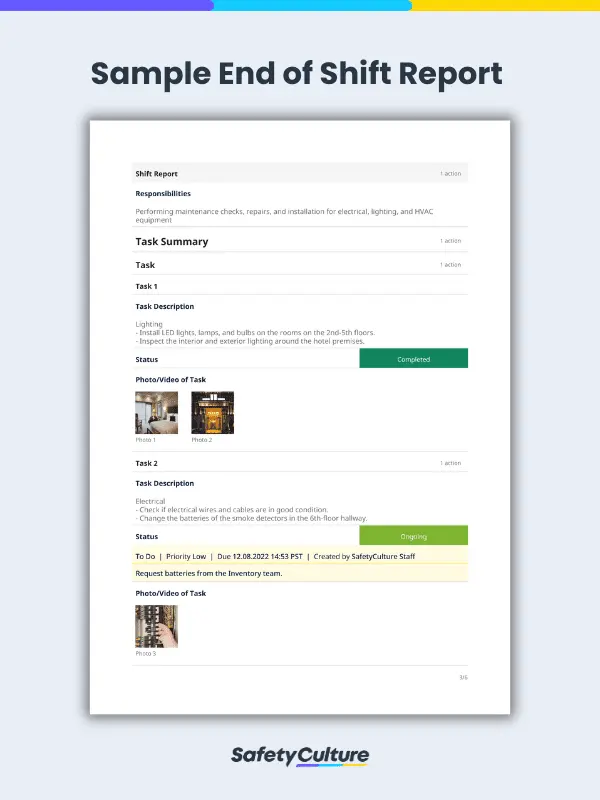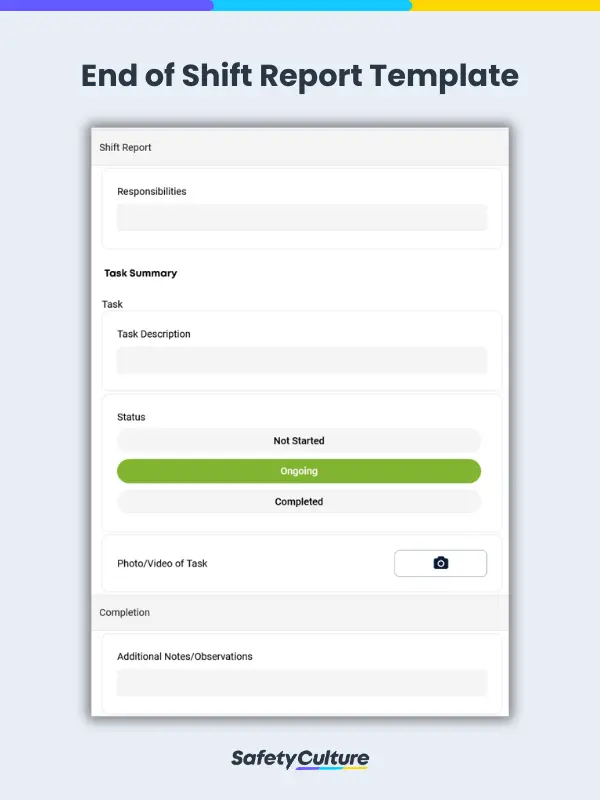What is an End of Shift Report?
An end-of-shift report is a document outlining vital information about a worker’s shift. Employees and supervisors often use an end-of-shift form to communicate all completed and ongoing tasks and provide a heads-up regarding issues encountered during the shift. Using this document, they can update the next person who will take over about safety, quality, and other things to watch out for during their shift, ensuring a smooth task turnover. An end-of-shift report is ideal for industries required to complete specific tasks on a daily basis, such as frontline workers in retail, healthcare, manufacturing, and hospitality.
Purpose
An end-of-shift or EOS report plays an important role in ensuring efficient operations and transitions from one employee to the next. It serves two purposes: reporting and problem-solving.
Sometimes called an end-of-day or EOD report, this document primarily functions as a communication tool that informs managers about the day-to-day happenings on their employees’ shifts. This report helps bridge information gaps among teams, especially employees handing things over to the next shift, and ensures everyone is on the same page about their shared goals.
Moreover, an EOS report also helps teams resolve problems in their daily operations. By giving workers a platform to document issues, they feel empowered to raise and address them effectively with the help of the right personnel. This record also provides insights to help management prevent them from recurring over and over.
Elements
Before drafting an end-of-shift report, it’s essential to know its key components first. Every EOS report should contain the following elements:
Employee Information
The first section of an end-of-shift report outlines basic details about the employee who filled out the form. This information is vital for tracking individual performance and instilling accountability among team members.
Listed below are essential details to include in your EOS report:
- Employee name – Who was the person assigned for the shift?
- Shift schedule – When does the employee’s shift start and end?
- Date completed – When and what time did they fill out the form?
- Location – Where did they work during their shift (e.g., on-site, remote)?
Tasks and Responsibilities
After filling out necessary employee information, the next step is to list your assigned jobs for the day. This section summarizes what happened during the day and provides a run-through of tasks and status by the end of the shift. In doing so, managers can monitor the progress of tasks assigned to their employees and stay on track with their business goals.
Task status often varies from one workplace to another. The ones listed below are the basics to help you get started:
- Not started
- Ongoing/In progress
- Pending/On hold
- For approval/Awaiting approval
- Completed/Accomplished
Problems and Issues Encountered
Inevitably, employees will face hurdles as they go about their shift, ranging from faulty equipment to violations of safety protocols. But whether small or big, it’s a must to report these incidents in the end-of-shift report. In this section, employees can describe issues they met and attach photos or videos to illustrate their points.
This detailed documentation allows designated personnel to understand the problem and resolve it accordingly. It also serves as a reference in case the issue happens again.
Action Items
Take one step ahead by listing solutions to address the issues raised. In this part, employees and managers can note specific actions to resolve problems in the previous section. They can assign those tasks to the appropriate personnel for a quicker turnaround time.
Handover Notes
Companies handling employees with multiple shifts will benefit from having a handover section in their daily end-of-shift report template. This portion allows workers to add assignments and reminders for the person in the next shift. Creating this document will help teams properly hand over tasks from one employee to the next.
End of Shift Report Example
The example below shows what an end-of-shift report should look like in digital format. It features a snapshot of the tasks assigned to and accomplished by a hotel maintenance staff.

FAQs about End of Shift Reports
As mentioned earlier, a shift report is a document outlining the undertakings of an employee during their shift. It supplements daily attendance sheets by digging deeper into the events that occurred that day. This document gives managers insights into the operations on the ground, enabling them to effectively track employee performance, communicate information across teams, and address issues before they get worse.
- Write down all relevant employee information such as their name, role, team or department, shift schedule, and location.
- List the responsibilities assigned for the day.
- Describe the assigned tasks and label their status accordingly (not started, in progress, completed, and so forth).
- Note other important updates outside the task descriptions.
- Sign off the report with the supervisor.
- Effectively write your end-of-shift report using the following tips:
- Write clearly and concisely.
- Go straight to the facts when recording updates and reporting issues.
- Document all relevant information about your pending, ongoing, and completed tasks.
- Add media attachments (photos and videos) to provide more detail on your report.
- Consider using templates to standardize end-of-shift reporting across the team.



